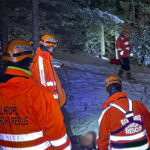Home »

The time of the precious fruit
By Bob Ede
Huckleberries are ripening in the mountains slightly later than last year. I keep a close eye out for these special berries and always try to pick at least a couple of gallons for freezing or jam. My mother used to make Huckleberry Grand Marnier Preserves. It was cherished in our house. I have tried to keep up with the tradition and make a few jars to give away at Christmas to friends and family members.
A week ago, I took to the mountains looking for berries. Most were still green, but I wondered the mountainside for about two hours and picked enough ripe ones (about six cups) for a batch of preserves. Tough picking. The next day, after work, I rushed home from work to cook the recipe. I entered the house and was met by my 15-year-old son, (who is starting to resemble a man); he had purple hands and lips. He had eaten them all! He said they were delicious.
The cool mornings of late summer are upon us. Autumn is in the air. No place is it more evident than in the mountains. If you look close, leaves are surrendering green, soon to be replaced with the flame of red and yellow.
It is huckleberry season. It takes a keen eye to find late summer huckleberries hanging at the base of tangled bushes.
Huckleberries depend on rain during late July and early August to have sufficient moisture allowing fruit to form. Many years produce few berries, disappointing avid huckleberry hunters.
Ever since I was a small boy it has been a ritual to seek out and pick at least a few gallons of this precious fruit. Huckleberries resemble blueberries in appearance but the flavor of the huckleberry is far superior. One taste to the uninitiated is enough to send someone heading for the mountains with an empty ice cream pail.
Huckleberries grow at an elevation of 4,000 to 7,000 feet. They can be found in 20 to 50-year-old burns or clear-cuts, slides and thin sub alpine forests. They need sufficient sunlight to allow berries to form yet thrive in the shelter of small bushes and trees.
I look for deadfalls in burned out areas. I am unsure if it is the protection from the elements that the berries seek or perhaps it finds sustenance on the nutrients of rotting deadfalls. It is not unusual to fill a bucket following the length of an old down tree.
Something to remember, if you are lucky enough to find an area graced with abundant berries, be warned, grizzlies and black bears love them too. It is important to stay alert, be aware of your surroundings and make some noise to reduce the chances of surprising a bear.
Few joys compare to being in the mountains, roaming the bush, the last of the summer sun warming your back, stopping here and there to fill a bucket. It’s true; the best things in life are free.
Bob Ede can be found in the bush near creek bottom looking for the two beer he stashed and lost a year earlier. Bob can be reached at [email protected].







